rocks
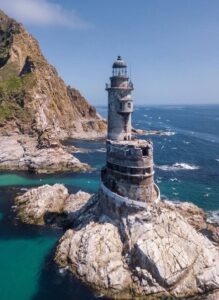 I like lighthouses. That is just a fact. I am particularly fascinated with unusual lighthouse. There are many lighthouses all over the world. They are, of course, used to direct ships away from shallow waters or dangerous rocks that lurk below the surface of the water. Today, there are more than 21,600 lighthouses worldwide, and there are a few that are still in use. In pre-GPS days, they played a vital role in the shipping industry, but these days they are usually used as tourist attractions. Many are privately owned, and are only used in an extreme emergency, when the electronic guidance systems are down. Some lighthouses are simply abandoned. I have mixed feelings about those, because when abandoned, they usually fall into disrepair, but there is something about abandoned buildings that has always intrigued me…even when they have fallen into disrepair.
I like lighthouses. That is just a fact. I am particularly fascinated with unusual lighthouse. There are many lighthouses all over the world. They are, of course, used to direct ships away from shallow waters or dangerous rocks that lurk below the surface of the water. Today, there are more than 21,600 lighthouses worldwide, and there are a few that are still in use. In pre-GPS days, they played a vital role in the shipping industry, but these days they are usually used as tourist attractions. Many are privately owned, and are only used in an extreme emergency, when the electronic guidance systems are down. Some lighthouses are simply abandoned. I have mixed feelings about those, because when abandoned, they usually fall into disrepair, but there is something about abandoned buildings that has always intrigued me…even when they have fallen into disrepair.
One such unusual, abandoned lighthouse is the Aniva Lighthouse in Sakhalin, Russia. The lighthouse is situated on a small rock called Sivuchya near the rocky Cape Aniva. It is difficult to reach, and can only be accessed by water. To make matters worse, the tides are strong there. Still, the breathtaking scenery makes the journey worth while. Construction started on Aniva Lighthouse in June 1937 and finished in October 1939, taking just over two years. Building this navigational structure was difficult: all of the construction materials had to be delivered by water. Severe weather conditions didn’t make the process any easier.
When I first saw a picture on the Aniva Lighthouse, it reminded me of the front of a ship. It almost looked like a 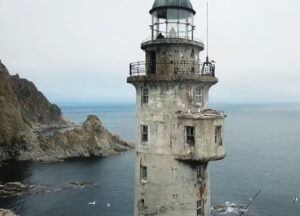 shipwreck, except for the lighthouse part, of course. Upon closer inspection, the lighthouse really doesn’t look like a ship at all, but maybe it was designed to give that illusion. The concrete tower, is painted to match the surrounding rocks, its stroboscopic lamp located 131 above the ground. The structure is round in shape and equipped with a bay window, the 9-floor tower stands on an oval base, which looks like it is coming out of the coastal rocks. Maybe that’s why it looks like a ship.
shipwreck, except for the lighthouse part, of course. Upon closer inspection, the lighthouse really doesn’t look like a ship at all, but maybe it was designed to give that illusion. The concrete tower, is painted to match the surrounding rocks, its stroboscopic lamp located 131 above the ground. The structure is round in shape and equipped with a bay window, the 9-floor tower stands on an oval base, which looks like it is coming out of the coastal rocks. Maybe that’s why it looks like a ship.
The Aniva Lighthouse was well equipped for living, no matter what the weather conditions. The basement was equipped with diesel engines and batteries. The kitchen was located on the ground floor along with the food storage The radio room, equipment room, and watch room were situated on the second floor of the lighthouse. As many as 12 people could be accommodated in the living quarters, located on the third, fourth and fifth floors, with each floor having a separate room. The interior of the quarters was modest, housing two bunk beds and small alcoves for personal belongings. Much of the light came in through small porthole windows. The storeroom was on the sixth floor. The seventh floor housed the mechanisms of a pneumatic siren, with its horn installed directly on the roof of the bay window. The eighth floor was used for fuel storage. The ninth floor housed the lens rotation mechanism of the lighthouse. The lantern rotated inside a bowl with about 660 pounds of mercury. The stroboscopic lamp was set in motion by a mechanism similar to a clockwork. Running through  the center of a spiral staircase leading to the very top of the tower, was a pipe with a suspended weight of 595 pounds inside. It took the weight three hours to reach the bottom, rotating the lamp in the process. After that, the lighthouse keeper had to rewind the system. The lighthouse had a range of 17.5 miles. That must have been a job.
the center of a spiral staircase leading to the very top of the tower, was a pipe with a suspended weight of 595 pounds inside. It took the weight three hours to reach the bottom, rotating the lamp in the process. After that, the lighthouse keeper had to rewind the system. The lighthouse had a range of 17.5 miles. That must have been a job.
It was decided to make the Aniva Lighthouse autonomous by re-equipping it to work from a nuclear power source in the 1990s. In 2006, the radioisotope generators were removed. The lighthouse has been abandoned ever since. These days it is a haven for the birds.

 My niece, Machelle Moore is just six months younger than my youngest daughter, Amy Royce. As young girls, they couldn’t really decide if they were friends or enemies, of course that all ended by the time they were about two years old. From that time on, they were friends. Before that, I think it was mostly a sharing problem…their toys, that is. Most kids that age don’t really like to share their toys, so it really wasn’t anything that unusual, and these two girls were both a bit stubborn. One thing I’ve learned in my lifetime is that stubborn people often make the best friends. While they might have disagreements, they never give up on things, and two things they never give up on are friends and marriage. So to this day, both girls are good friends, and both have enjoyed a long marriage with their spouses. While they live a long way away from each other now, they will always be close as cousins.
My niece, Machelle Moore is just six months younger than my youngest daughter, Amy Royce. As young girls, they couldn’t really decide if they were friends or enemies, of course that all ended by the time they were about two years old. From that time on, they were friends. Before that, I think it was mostly a sharing problem…their toys, that is. Most kids that age don’t really like to share their toys, so it really wasn’t anything that unusual, and these two girls were both a bit stubborn. One thing I’ve learned in my lifetime is that stubborn people often make the best friends. While they might have disagreements, they never give up on things, and two things they never give up on are friends and marriage. So to this day, both girls are good friends, and both have enjoyed a long marriage with their spouses. While they live a long way away from each other now, they will always be close as cousins.
Machelle is married to Steve Moore, and they have two sons. They love camping in the Big Horn Mountains, which is near their home in Powell, Wyoming. In the summer they go camping as much as possible, although these days their boys can’t always go along…at least, not Weston, their oldest, who works. Easton usually goes, but that will probably change as he gets older too. Machelle and her husband, Steve love to be in the great outdoors. The love rock hunting, and looking for artifacts. They could walk the hillsides for hours in their search for the perfect stones. I think I could easily see them with a mining claim where they looked for gemstones. I’m sure they could make so beautiful things out of all the great stones they have found.
These days, Machelle is into all things health. She is doing her own studies on vitamins, immune systems, and healthy eating. I guess we are all trying to make our way through all the health issues of the current pandemic 
 and the truth is that we have to all work out our own health as we see fit. We all have different ideas on masks, social distancing, closures, and safety. We can only share what we have learned, and let everyone make their own choices. That’s all any of us are asking. The freedom to choose for ourselves. Machelle is a strong woman, who follows her heart, and I think she has chosen well for her life. Today is Machelle’s birthday. Happy birthday Machelle!! Have a great day!! We love you!!
and the truth is that we have to all work out our own health as we see fit. We all have different ideas on masks, social distancing, closures, and safety. We can only share what we have learned, and let everyone make their own choices. That’s all any of us are asking. The freedom to choose for ourselves. Machelle is a strong woman, who follows her heart, and I think she has chosen well for her life. Today is Machelle’s birthday. Happy birthday Machelle!! Have a great day!! We love you!!
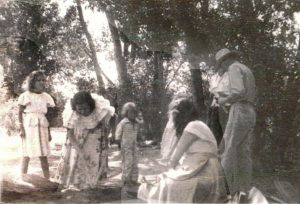 My grandfather, George Byer was always a rock hunter. In hard times, when trips were not possible, he shared his love of rocks with his family. You didn’t have to go far to look for rocks…you didn’t even have to leave home. Still, when you raise a family of rock lovers, the back yard gets picked over pretty quickly. Nevertheless, there was always someplace that he could take his family for a picnic and rock hunting excursion, and every one of the kids became rock lovers too, as did many of his grandchildren, great grandchildren, and the list has continued long after his passing.
My grandfather, George Byer was always a rock hunter. In hard times, when trips were not possible, he shared his love of rocks with his family. You didn’t have to go far to look for rocks…you didn’t even have to leave home. Still, when you raise a family of rock lovers, the back yard gets picked over pretty quickly. Nevertheless, there was always someplace that he could take his family for a picnic and rock hunting excursion, and every one of the kids became rock lovers too, as did many of his grandchildren, great grandchildren, and the list has continued long after his passing.
If you aren’t a rock lover, you could so easily miss the beauty that is found in many of the stones around us. On the outside, they may look like they are just a plain black, brown, or white stone, but when it is cut or broken open, you find a stunningly colorful stone inside, even a gem in some cases. Of course, these days, we have to be careful where we do our rock hunting, because there are rock hunters who have staked and registered their claim on certain areas. But as long as you steer clear of those areas, rock hunting is a free way to get out and find nature’s best treasures.
Grandpa Byer loved his rocks so much that he later bought a rock polisher, and made beautiful jewelry and key chains from the rocks he found. I think many of his grandchildren have been blessed to receive such a gift as a memento of the treasure that was our grandpa. These pieces are precious to us. Somehow, they are filled with all the stories our parents have told us about the joys of rock hunting with their family. I think most of them loved rock hunting all their lives. I’ll never forget my mom telling me about their rock hunting trips, sometimes 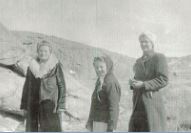 to Independence Rock, sometimes by the river, and sometimes the kids went by themselves. Wherever they went, they always came back with the treasured rocks.
to Independence Rock, sometimes by the river, and sometimes the kids went by themselves. Wherever they went, they always came back with the treasured rocks.
The rock stories remained even after my grandparents were in Heaven. Of course they did. My aunts and uncles were so blessed to carry those memories in their hearts for their entire lives, and we were blessed that they could pass them along to their own children and grandchildren. I don’t think I ever grew tired of hearing about their trips to find rocks. My mom used to tell me all about how much fun the had. These are the kind of memories that stay with you long after the people in them are gone.
 While visiting Alaska a few years ago, Bob and I kept hearing about Captain James Cook. I suppose I had probably heard a little about him at one point or another during my school years, but as often happens with kids, I wasn’t really interested…at least not until I saw Alaska for myself. Then, the places that were discussed in history actually came to life, because I was there in person. In reality, Captain Cook had a direct impact on several areas of the west coast of the United States, including the Puget Sound in Washington and areas of Oregon. Cook’s two ships, the Discovery and Resolution, had worked their way northwest from what is now Oregon and Puget Sound, along the British Columbia and Alaska coast, hoping to find the long sought after Northwest Passage to Europe.
While visiting Alaska a few years ago, Bob and I kept hearing about Captain James Cook. I suppose I had probably heard a little about him at one point or another during my school years, but as often happens with kids, I wasn’t really interested…at least not until I saw Alaska for myself. Then, the places that were discussed in history actually came to life, because I was there in person. In reality, Captain Cook had a direct impact on several areas of the west coast of the United States, including the Puget Sound in Washington and areas of Oregon. Cook’s two ships, the Discovery and Resolution, had worked their way northwest from what is now Oregon and Puget Sound, along the British Columbia and Alaska coast, hoping to find the long sought after Northwest Passage to Europe.
In early June 1778, Captain Cook and his men were in the Cook Inlet, hoping it would lead to the imagined passageway to Europe. It didn’t, of course, but once again Cook sent his crew exploring in small boats. Their adventures there led to the naming of Turnagain Arm, which Captain Cook originally called River Turnagain. It was so named because it was a disappointing “turn again” for Cook’s crew. The problem they were having was because Turnagain is subject to climate extremes and large tide ranges. During high tide, taking a boat in is simple, but if you don’t get out before low tide, you will find yourself fighting the quicksand-like mudflats that make up the beaches along Turnagain Arm in low tide.
In the times that Captain Cook was exploring for England, it was customary to name places after places and people in England. The visit to Cook Inlet was part of Cook’s longer exploration of the Alaska coast from which included a stop in Prince William Sound, which Cook named, along with Bligh Reef in the Sound. Bligh Reef would become famous in 1989 when the tanker Exxon Valdez ran aground on it and spilled millions of gallons of crude oil. Prince William Sound, interestingly, was almost named “Sandwich Sound” by Cook after the Earl of  Sandwich in England, and who also, by the way, invented the sandwich as a food item. The Sound was renamed by Cook after Prince William, a descendent of the royal family when his journal was published. Leaving Prince William Sound, Cook ventured west along the Alaska coast to explore further, and after leaving Cook Inlet, he named Bristol Bay after Admiral Earl of Bristol, and Norton Sound after Sir Fletcher Norton, then Speaker of the British House of Commons. As he continued his quest for the Northwest Passage, Cook entered the Chukchi Sea through the Bering Strait and, amazingly, got as far as Icy Cape, on Alaska’s northwest coast, before being stopped by ice. In fact, the two ships were almost trapped by ice the off of Icy Cape.
Sandwich in England, and who also, by the way, invented the sandwich as a food item. The Sound was renamed by Cook after Prince William, a descendent of the royal family when his journal was published. Leaving Prince William Sound, Cook ventured west along the Alaska coast to explore further, and after leaving Cook Inlet, he named Bristol Bay after Admiral Earl of Bristol, and Norton Sound after Sir Fletcher Norton, then Speaker of the British House of Commons. As he continued his quest for the Northwest Passage, Cook entered the Chukchi Sea through the Bering Strait and, amazingly, got as far as Icy Cape, on Alaska’s northwest coast, before being stopped by ice. In fact, the two ships were almost trapped by ice the off of Icy Cape.
During his travels, Captain Cook named many other places, including Mount Edgecumbe and Cape Edgecumbe after George, Earl of Edgecumbe. He broke from protocol in naming Mount Fairweather and Cape Fairweather, using the fact that he had good weather at the time of his exploration, as inspiration for the names. Cross Sound was so named because he found it on May 3, designated on his calendar as Holy Cross day. Cape Suckling was named after Maurice Suckling, comptroller of the Royal Navy when Cook left England. Controller Bay was probably also named after Maurice Suckling, but the Russians translated the name to Zal Kontrolyer on the Hydrogaphy Department Chart 1378, dated 1847, and so it remained Controller Bay. Cape Hinchinbrook was named after Viscount Hinchinbroke. Snug Corner Cove was so named because Captain Cook thought, “And a very snug cove it is.” Montague Island was named after John Montagu, Earl of Sandwiche, the son of Viscount Hinchinbroke. The list of names and their origins goes on and on, but I find these the most interesting.
During his third visit to the Sandwiche Islands, which we now know as Hawaii, Captain James Cook lost his life  in a mob fight with the Hawaiian natives, who wanted one of his boats. As the men came ashore, the Hawaiians greeted Cook and his men by hurling rocks at them. They then stole a small cutter vessel from the Discovery. Negotiations with King Kalaniopuu for the return of the cutter collapsed after a lesser Hawaiian chief was shot to death, and a mob of Hawaiians descended on Cook’s party. The captain and his men fired on the angry Hawaiians, but they were outnumbered. Only a few managed to escape to the safety of the Resolution. Captain Cook was killed by the mob on February 14, 1779. A few days later, the Englishmen retaliated by firing their cannons and muskets at the shore, killing some 30 Hawaiians. The Resolution and Discovery eventually returned to England.
in a mob fight with the Hawaiian natives, who wanted one of his boats. As the men came ashore, the Hawaiians greeted Cook and his men by hurling rocks at them. They then stole a small cutter vessel from the Discovery. Negotiations with King Kalaniopuu for the return of the cutter collapsed after a lesser Hawaiian chief was shot to death, and a mob of Hawaiians descended on Cook’s party. The captain and his men fired on the angry Hawaiians, but they were outnumbered. Only a few managed to escape to the safety of the Resolution. Captain Cook was killed by the mob on February 14, 1779. A few days later, the Englishmen retaliated by firing their cannons and muskets at the shore, killing some 30 Hawaiians. The Resolution and Discovery eventually returned to England.
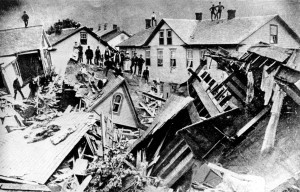 Over the years, man has tried many ways to harness water. Water is a necessity to life, and without it, all things would die off. Some projects worked out better than others, and some simply needed to be replaced sooner than they were in order to prevent disaster. A good example of that is the earthen dam. An earthen dam is a dam that is built out of rocks and dirt, instead of steel and concrete. Of course, when dams were first built, earthen dams were the only way to go, but after so many failed, a new type of dam had to be designed, in order to save lives. One such failure was the earthen dam built in 1840 on the Little Conemaugh River, fourteen miles upstream from Johnstown, Pennsylvania. Johnstown is sixty miles east of Pittsburgh, in a valley near the Allegheny, Little Conemaugh, and Stony Creek Rivers. The area lies in a floodplain that has had frequent disasters. This time would prove to be one of them. At nine hundred by seventy two feet, this dam was the largest earthen dam in the United States, creating the largest man-made lake at that time…Lake Conemaugh. At a time when here were no railroads in the area for transporting goods, the dam and its extensive canal system was the only way to transport goods to the people, but it became obsolete as the railroads replaced the canal as a means of transporting goods. The canal system was left to become a victim of the elements, and with its neglect, also came the neglect of the dam. In reality, people just didn’t really think anything would happen, and they most likely looked at the dam as just a part of the landscape.
Over the years, man has tried many ways to harness water. Water is a necessity to life, and without it, all things would die off. Some projects worked out better than others, and some simply needed to be replaced sooner than they were in order to prevent disaster. A good example of that is the earthen dam. An earthen dam is a dam that is built out of rocks and dirt, instead of steel and concrete. Of course, when dams were first built, earthen dams were the only way to go, but after so many failed, a new type of dam had to be designed, in order to save lives. One such failure was the earthen dam built in 1840 on the Little Conemaugh River, fourteen miles upstream from Johnstown, Pennsylvania. Johnstown is sixty miles east of Pittsburgh, in a valley near the Allegheny, Little Conemaugh, and Stony Creek Rivers. The area lies in a floodplain that has had frequent disasters. This time would prove to be one of them. At nine hundred by seventy two feet, this dam was the largest earthen dam in the United States, creating the largest man-made lake at that time…Lake Conemaugh. At a time when here were no railroads in the area for transporting goods, the dam and its extensive canal system was the only way to transport goods to the people, but it became obsolete as the railroads replaced the canal as a means of transporting goods. The canal system was left to become a victim of the elements, and with its neglect, also came the neglect of the dam. In reality, people just didn’t really think anything would happen, and they most likely looked at the dam as just a part of the landscape.
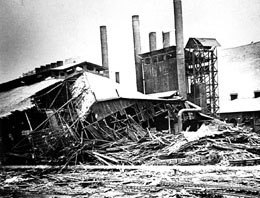
By 1889, Johnstown had grown to a population of 30,000 people, many of whom worked in the steel industry…ironically. On May 30, 1889, it began to rain, and continued steadily all day. No one really gave any thought the potential harm so much rain could bring to the nearly sixty year old earthen dam. The dam had a spillway, and so everything seemed safe, but the spillway became clogged with debris, that could not be dislodged. On May 31, 1889, an engineer at the dam saw the warning signs, but the only way to notify anyone was to ride his horse into the village of South Fork to warn the people…a ride that took an eternity in the face of the impending disaster. Nevertheless, it should have been enough time, but the telegraph lines were down, and no warning ever reached Johnstown. At 3:10pm, the dam collapsed with a roar that could be heard for miles. The water, moving at 40 miles per hour barreled down on the towns in it’s path, wiping out everything that got in its way. At Johnstown, 2,200 people lost their lives that day, including one Thomas Knox and his wife. Thomas, like a large number of the flood victims was never found. While I’m not sure that Thomas Knox is related to my husband, Bob Schulenberg’s family, it is quite likely that he is, as there are a number of Thomas Knox’s in the family…though none that I have found so far that died in the Johnstown Flood.
The people in the path of the raging flood waters, were tossed around, along with all that debris, including thirty three train engines that were pulled into the flood waters. I’m sure that for many, death did not come  from drowning, but rather from blunt force trauma. Nevertheless, some people did manage to climb atop the debris, only to be burned alive when much of the debris caught fire, when it was caught in a bridge downstreem and burst into flames. There was a report of a baby that survived on the floor of a house that floated 75 miles downstream, but that was something that was not confirmed. It was during the Johnstown flood, that the American Red Cross handled its first major relief effort. Clara Barton arrived five days after the flood to lead the relief. In the end, it took five years to rebuild Johnstown, which went through disastrous floods in 1936 and 1977. I have to wonder if they should just move the town, but with no major floods since 1977, it’s hard to say.
from drowning, but rather from blunt force trauma. Nevertheless, some people did manage to climb atop the debris, only to be burned alive when much of the debris caught fire, when it was caught in a bridge downstreem and burst into flames. There was a report of a baby that survived on the floor of a house that floated 75 miles downstream, but that was something that was not confirmed. It was during the Johnstown flood, that the American Red Cross handled its first major relief effort. Clara Barton arrived five days after the flood to lead the relief. In the end, it took five years to rebuild Johnstown, which went through disastrous floods in 1936 and 1977. I have to wonder if they should just move the town, but with no major floods since 1977, it’s hard to say.
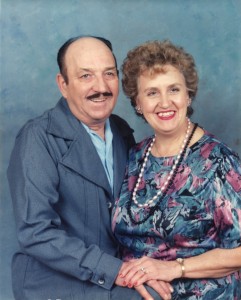 Because of my broken shoulder, and the fact that I am still taking an average on one pain pill a day, I can’t drive. My boss, Jim Stengel has been picking me up for work every day, and since I am back to work all day, and I can’t drive, I decided to take a walk during lunch. The cemetery is near my office, and so was a logical choice for a destination. As I walked, I took pictures of a large number of graves, because I am a member of the Find A Grave site that sets up memorials for people who have passed away, so their loved ones can add the information to family trees. That part of my walk was something that made me feel like I had accomplished something good, but it was something that happened a little later in the walk that I found to be so sweet that I had to share it.
Because of my broken shoulder, and the fact that I am still taking an average on one pain pill a day, I can’t drive. My boss, Jim Stengel has been picking me up for work every day, and since I am back to work all day, and I can’t drive, I decided to take a walk during lunch. The cemetery is near my office, and so was a logical choice for a destination. As I walked, I took pictures of a large number of graves, because I am a member of the Find A Grave site that sets up memorials for people who have passed away, so their loved ones can add the information to family trees. That part of my walk was something that made me feel like I had accomplished something good, but it was something that happened a little later in the walk that I found to be so sweet that I had to share it.
During my walk, I stopped by my parents’ graves. I took a picture there, just because I often do. Maybe it’s to keep them close in my memory. I can’t really say. Then I straightened some of the flowers we have on their graves, and when I looked down, I noticed a nickel on the base of the headstone. There was no doubt in my mind where that nickel came from, because my niece Jenny Spethman, and her husband Steve often bring their children by to visit the grave of their baby sister, Laila, which is close by my parents’ grave. They never fail to stop at their great grandparents’ grave too. They loved them so much.
 In the five years since their sister’s passing, Jenny and Steve’s children have come to the grave often, and since it is so close, they visit my parents’ graves too. During that time, I have seen so many gifts they have left for their great grandparents, whom they loved very much. They have left rocks, toy guns, cars, and now a nickel. There were many others too. They give the best of themselves. The things that mean the most to them, are the things that they want to share with their great grandparents. Our is a close family, and the great grandchildren were very close with their great grandparents. Loss is hard on everyone, but for the little kids, it is so much to accept. They often don’t exactly understand what happened…even when they know what death is, they still wonder when their loved one is coming home. Eventually they learn, especially when death becomes such a glaring reality, like the passing of their baby sister. Still, in their trusting heart, they know that their God has their loved ones, safe in His loving arms. To leave a gift on the headstone is another form of trust. They trust that God will tell their loved on about the gift they left, and about the love they feel for their loved one…forever.
In the five years since their sister’s passing, Jenny and Steve’s children have come to the grave often, and since it is so close, they visit my parents’ graves too. During that time, I have seen so many gifts they have left for their great grandparents, whom they loved very much. They have left rocks, toy guns, cars, and now a nickel. There were many others too. They give the best of themselves. The things that mean the most to them, are the things that they want to share with their great grandparents. Our is a close family, and the great grandchildren were very close with their great grandparents. Loss is hard on everyone, but for the little kids, it is so much to accept. They often don’t exactly understand what happened…even when they know what death is, they still wonder when their loved one is coming home. Eventually they learn, especially when death becomes such a glaring reality, like the passing of their baby sister. Still, in their trusting heart, they know that their God has their loved ones, safe in His loving arms. To leave a gift on the headstone is another form of trust. They trust that God will tell their loved on about the gift they left, and about the love they feel for their loved one…forever.
 Some would call that childlike innocence, believing in fairy tales, or even a child’s imagination, but I say that it is the faith of a child…unmarred by so many years of being told that God doesn’t do much in this day and age, that miracles are a thing of the past, or that we are on our own here. They are so close to God, that the world hasn’t had time to muddy the waters of their faith. They simply believe that their loving God cares about every little thing in their life, including the gift they wanted to give their great grandparents. Their faith is not spoiled by this world. They simply know that their God will tell their loved on that they love them…always and forever. That is the faith of a child, and it was so sweet for me to see. And all it took was a nickel left on a headstone.
Some would call that childlike innocence, believing in fairy tales, or even a child’s imagination, but I say that it is the faith of a child…unmarred by so many years of being told that God doesn’t do much in this day and age, that miracles are a thing of the past, or that we are on our own here. They are so close to God, that the world hasn’t had time to muddy the waters of their faith. They simply believe that their loving God cares about every little thing in their life, including the gift they wanted to give their great grandparents. Their faith is not spoiled by this world. They simply know that their God will tell their loved on that they love them…always and forever. That is the faith of a child, and it was so sweet for me to see. And all it took was a nickel left on a headstone.

 My grand niece, Hattie Joy Parmely, is celebrating a milestone today. She has arrived at her very first birthday. Her mom, Ashley Parmely tells me that Hattie Joy has lived up to her name quite well, because she is a joy for her whole family to be around. Hattie is a very busy little girl, and sometimes it’s hard for her mom to get pictures of her, because she is moving so fast. I suppose that is why she takes videos to share. And in many ways, I like to see the videos, because it shows me the true Hattie Joy personality that is quickly developing in this baby girl. Hattie is turning into a little toddler now, because she has learned to walk, and she even has three teeth now, so she is starting to love snacking too.
My grand niece, Hattie Joy Parmely, is celebrating a milestone today. She has arrived at her very first birthday. Her mom, Ashley Parmely tells me that Hattie Joy has lived up to her name quite well, because she is a joy for her whole family to be around. Hattie is a very busy little girl, and sometimes it’s hard for her mom to get pictures of her, because she is moving so fast. I suppose that is why she takes videos to share. And in many ways, I like to see the videos, because it shows me the true Hattie Joy personality that is quickly developing in this baby girl. Hattie is turning into a little toddler now, because she has learned to walk, and she even has three teeth now, so she is starting to love snacking too.
Hattie tries to be very helpful. Her dad, my nephew, Eric Parmely is always working on their house, because 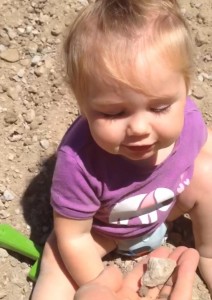
 they bought it as a fixer upper, and they are quickly turning it into their dream home. Hattie is very much on board with the projects that her mom and dad are doing, and while she may not be the greatest help to them right now, she still helps…like it or not. Of course, helping her dad build is not the only big job that little Hattie does. She makes a great motor for her big sister, Reagan’s tricycle. I suppose it’s a good thing that Reagan isn’t very heavy, but for a little one year old girl, Hattie is fully capable of giving her big sister just the push she needs…provided they don’t run into any obstacles and big sister decides to back up, because Hattie isn’t too sure of how to back up yet. Hattie also helps her mom with the earth moving projects they are doing…one rock or handful of dirt at a time. She has a little trouble with that job though. Once she gets to rocks and dirt in her mom’s hand, she knocks them back out. Some jobs just take a little bit of training.
they bought it as a fixer upper, and they are quickly turning it into their dream home. Hattie is very much on board with the projects that her mom and dad are doing, and while she may not be the greatest help to them right now, she still helps…like it or not. Of course, helping her dad build is not the only big job that little Hattie does. She makes a great motor for her big sister, Reagan’s tricycle. I suppose it’s a good thing that Reagan isn’t very heavy, but for a little one year old girl, Hattie is fully capable of giving her big sister just the push she needs…provided they don’t run into any obstacles and big sister decides to back up, because Hattie isn’t too sure of how to back up yet. Hattie also helps her mom with the earth moving projects they are doing…one rock or handful of dirt at a time. She has a little trouble with that job though. Once she gets to rocks and dirt in her mom’s hand, she knocks them back out. Some jobs just take a little bit of training.
A girl can’t spend all her time working though, and Hattie loves to dance. She is a little bit too young to go clubbing right now, so she settles for struttin’ her stuff whenever her mom puts on some music. Hattie likes dancing so much, that she has even incorporated it into one of her other favorite activities…eating. She puts some food in 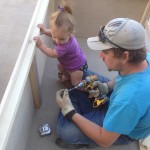
 her mouth, and then proceeds to dance it down to her tummy…all the while, sitting in her highchair. Now, not everyone can pull that one off, but Hattie does it with style…and with a smile on her little face. It would seem that our Miss Hattie Joy is a born entertainer. With everything she’s got going for her, who knows maybe she will be on Broadway someday, but I guess we will have to let her get a few years under her belt, before we will really know for sure. Today is Hattie’s 1st birthday. Happy birthday Miss Hattie Joy!! Have a great day!! We love you!!
her mouth, and then proceeds to dance it down to her tummy…all the while, sitting in her highchair. Now, not everyone can pull that one off, but Hattie does it with style…and with a smile on her little face. It would seem that our Miss Hattie Joy is a born entertainer. With everything she’s got going for her, who knows maybe she will be on Broadway someday, but I guess we will have to let her get a few years under her belt, before we will really know for sure. Today is Hattie’s 1st birthday. Happy birthday Miss Hattie Joy!! Have a great day!! We love you!!
 As we grow to adulthood, our life experiences shape the people we become, and one of the biggest life experiences we have is the relationship with our parents. Whether we realize it or not, we are commonly more like one parent than the other, and we can relate to one parent easier than the other. It doesn’t mean that we love one more than the other, just that we have more in common with one than with the other. That doesn’t even determine how well we get along with that parent that we are most alike. Some people can be exactly like on parent, and yet they fight with that parent quite a bit, or sometimes they just get along perfectly with that parent that they are most alike. My sisters and I got along very well with our parents, but as kids, we all had our moments…or was it years. My parents might say it was years. Nevertheless, I can tell you which of us was more like Mom and which of us was more like Dad.
As we grow to adulthood, our life experiences shape the people we become, and one of the biggest life experiences we have is the relationship with our parents. Whether we realize it or not, we are commonly more like one parent than the other, and we can relate to one parent easier than the other. It doesn’t mean that we love one more than the other, just that we have more in common with one than with the other. That doesn’t even determine how well we get along with that parent that we are most alike. Some people can be exactly like on parent, and yet they fight with that parent quite a bit, or sometimes they just get along perfectly with that parent that they are most alike. My sisters and I got along very well with our parents, but as kids, we all had our moments…or was it years. My parents might say it was years. Nevertheless, I can tell you which of us was more like Mom and which of us was more like Dad.
Talking to my niece, Lacey Stevens, I find that my sister, Alena Stevens was a lot like our mom, is a way that had really never occurred to me before. Lacey tells me that her mom, reminds her a lot of her grandma, my mom, Collene Spencer, as she gets older. Our mom has always been a rock collector. It was something her dad, my grandpa, George Byer loved to do, and something he instilled in his kids by taking them on many rock hunting trips. Mom continued to look for pretty rocks for the rest of her life. I’m not sure why it surprised me to find out that Alena loves to find pretty rocks too. She has a prized collection of the rocks she has found, and she wants to keep them all. Mom was that way. She had a rock garden, and if one of the rocks was moved, she knew it. Each rock had its proper place. If one of the grandchildren took one of the rocks to play with, Mom knew it. I don’t know if Alena is that way too, but I suspect that she is, because a true rock  collector knows her collection, and where each on belongs in the display.
collector knows her collection, and where each on belongs in the display.
Another way that Alena is like our mom…one that Lacey finds funny, is that Alena is always getting on her kids about coming over to visit more often. I think that is a trait all my sisters and I have in common with our parents. Our families are very important to us, and we will tell them to come by more often and call more often…basically keep in touch with us better. We didn’t have kids so they could go off and we never hear from them. So while Lacey finds that funny, I find it very normal, as I’m sure my sister, Alena does. Today is Alena’s birthday. Happy birthday Alena!! Have a great day!! We love you!!
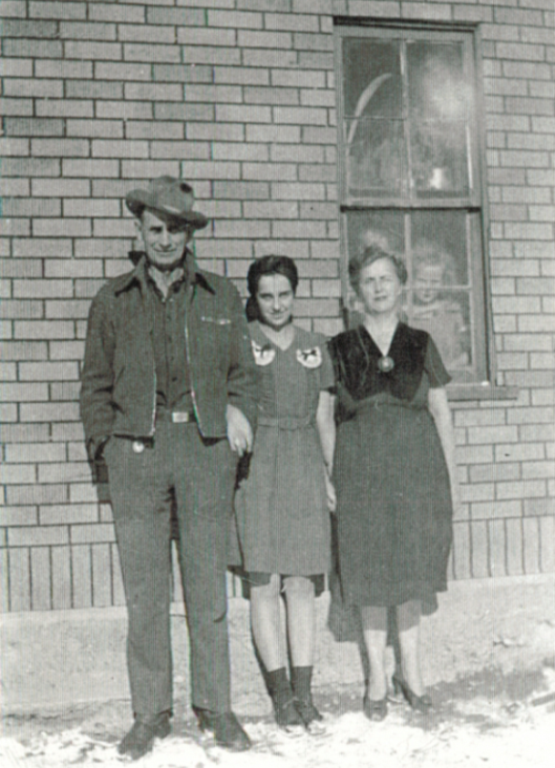 When most people think of the barracks, they think of a military facility, but not so my mother’s family. For all of their childhood, the barracks meant the bedroom. No, it isn’t because that is what they called the bedroom, because, they didn’t call the bedroom that. While visiting with my aunts, Sandy Pattan and Bonnie McDaniels, and cousins Susie Young, Shannon Limmer, and Jamie Patsie, after my mother passed away a week ago, we got on the subject of precious memories…which naturally took us to my grandpa and grandma, George and Hattie Byer’s house in North Casper, where they lived for many years right next door to his mother, my great grandma, Edna Byer. The two houses were very similar, but my grandparents house had an extra, very long bedroom attached to the back of the house. Grandma and Grandpa’s room was in from of that back bedroom, and there was another room where the two boys slept, but the girls all shared that huge back bedroom.
When most people think of the barracks, they think of a military facility, but not so my mother’s family. For all of their childhood, the barracks meant the bedroom. No, it isn’t because that is what they called the bedroom, because, they didn’t call the bedroom that. While visiting with my aunts, Sandy Pattan and Bonnie McDaniels, and cousins Susie Young, Shannon Limmer, and Jamie Patsie, after my mother passed away a week ago, we got on the subject of precious memories…which naturally took us to my grandpa and grandma, George and Hattie Byer’s house in North Casper, where they lived for many years right next door to his mother, my great grandma, Edna Byer. The two houses were very similar, but my grandparents house had an extra, very long bedroom attached to the back of the house. Grandma and Grandpa’s room was in from of that back bedroom, and there was another room where the two boys slept, but the girls all shared that huge back bedroom.
We always loved to go play back there, because it was a long room with lots of beds, and it just seemed very interesting to all the grandkids. I suppose that to the aunts and uncles, it was just normal, be we had really never seen anything like it. We began to talk about what spending the night in that back bedroom was like. There was no heat in that back room, so at night grandpa would heat rocks in the cook stove, and wrap them in a towel. Once the girls were tucked into bed, under a mountain of blankets, grandpa would come in and stick those towel wrapped rocks under the blankets at their feet. What a wonderful thing those rocks were. Aunt Bonnie tells me that they would immediately put their feet on those rocks, and before long, they would be all warm and cozy for the night. In the absence of heat, the blankets and the rocks did the job of keeping them warm quite well.
For us grandkids, the best way to play in that room in the winter cold, was to keep moving. I don’t think my aunts spent much time in there other than sleeping, because it was just too cold in winter. The main living room and kitchen were heated by the cook stove, and I’m here to tell you that those rooms were very warm…a fact that was just fine with me, since I have a tendency to get cold. Nevertheless, after some time in the main part of the house, the cooler bedroom could come as a nice change, until you got cold, then you went back out to the main rooms to warm up.
I had always wondered about the house with the long bedroom, and how it came to be…but no longer. As we were talking about those old days, my Aunt Sandy cleared that question right up. It turns out that both houses, Great Grandma’s and my grandparents, were originally old barracks from the air force base that used to be 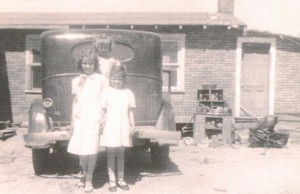 located in Casper. I don’t know for sure when they became the two houses, but that is what happened. My grandparents’ house had the added barracks to it, making up the big back bedroom where so many childhood memories for my mom, aunts, uncles, and many of the grandchildren, were built. In those days, times were tough, and people had to make do with what they had. In my opinion, the barracks and the houses attached to them, were more than just a way to make do. They are the houses I remember fondly from my own childhood years. We used to love going to visit Grandma and Grandpa. The house was always cozy, and my grandparents always pleased to see us. I get a warm cozy feeling just thinking about those visits.
located in Casper. I don’t know for sure when they became the two houses, but that is what happened. My grandparents’ house had the added barracks to it, making up the big back bedroom where so many childhood memories for my mom, aunts, uncles, and many of the grandchildren, were built. In those days, times were tough, and people had to make do with what they had. In my opinion, the barracks and the houses attached to them, were more than just a way to make do. They are the houses I remember fondly from my own childhood years. We used to love going to visit Grandma and Grandpa. The house was always cozy, and my grandparents always pleased to see us. I get a warm cozy feeling just thinking about those visits.
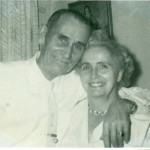 One memory from when I was little is of Grandpa’s rocks. He had many of them, because he was a rock collector. Grandpa went many places to find his rocks…and no place at all. That’s because great rocks could be found just about anywhere, and you never really knew what they could look like until you put then in a rock tumbler and polished them up. Then, even the rock that had seemed so plain, could turn into a beautiful stone. To find that special rock, you had to have an eye for it, and my grandpa really had an eye for it.
One memory from when I was little is of Grandpa’s rocks. He had many of them, because he was a rock collector. Grandpa went many places to find his rocks…and no place at all. That’s because great rocks could be found just about anywhere, and you never really knew what they could look like until you put then in a rock tumbler and polished them up. Then, even the rock that had seemed so plain, could turn into a beautiful stone. To find that special rock, you had to have an eye for it, and my grandpa really had an eye for it.
He had some beauties. I always wondered how he could find so many beautiful stones…and where he could find them. I liked to looks for pretty rocks too, but aside from an agate or two, I never really turned up much that was very pretty, much less stunning, like his were. Of course, I didn’t have a rock tumbler to bring out the beauty, but still, I’m not sure that I would have had the eye for the rock that had the potential to become a beautiful stone.
Grandpa spent years looking for rocks…possibly his entire life. I can picture him as a little boy, looking around and finding a rock here and there that had touches of color in them. Maybe some pinks or whites mixed in with the gray or black that most of us see. When I think of rocks, they are all plain and ugly, but I have to wonder how many beauties I passed up because my mind couldn’t see inside the rock…couldn’t see the rock’s potential, but Grandpa could see it. He could see inside the rocks…see their potential, and he knew how to bring the inside of the rock out and turn it into a beautiful stone.
It was almost as if Grandpa knew how to talk to the rocks…coax the beautiful stone out of  the simple gray or black rock. Maybe it’s just because he was able to see the beauty in many things. Grandpa had so much love to give. And he wanted to share his love of nature with his family. They would go on rock hunting treks. The kids got to do what so many kids would love to do…hunt rocks and bring them home. And nobody stopped them from bringing their treasures home…and then he could take those treasures and turn them into something more. Of course, I don’t suppose Grandpa had a rock tumbler back in those days, still a little water could bring out the different colors in an otherwise Plain Jane of a rock, I’m sure. Eventually, with the invention of the rock tumbler, Grandpa was able to show the rest of us what he was always able to see…the beauty that lies inside of the rock.
the simple gray or black rock. Maybe it’s just because he was able to see the beauty in many things. Grandpa had so much love to give. And he wanted to share his love of nature with his family. They would go on rock hunting treks. The kids got to do what so many kids would love to do…hunt rocks and bring them home. And nobody stopped them from bringing their treasures home…and then he could take those treasures and turn them into something more. Of course, I don’t suppose Grandpa had a rock tumbler back in those days, still a little water could bring out the different colors in an otherwise Plain Jane of a rock, I’m sure. Eventually, with the invention of the rock tumbler, Grandpa was able to show the rest of us what he was always able to see…the beauty that lies inside of the rock.

